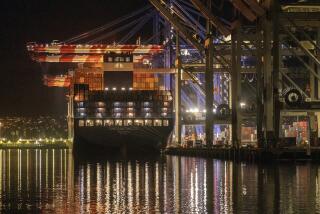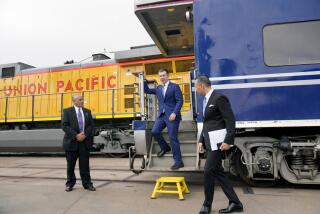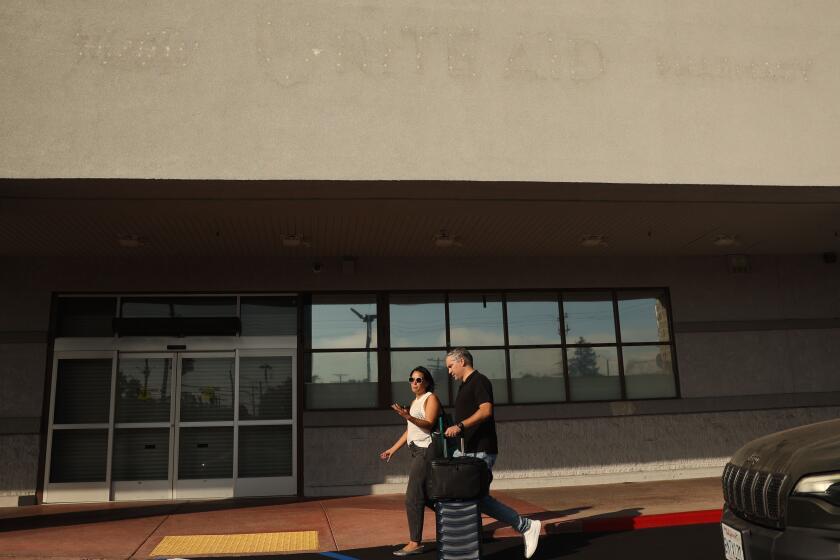Exports post gains at Port of Los Angeles
At the ports of Los Angeles and Long Beach, imports rule. Improvement projects are designed around the fact that the harbor handles 40% of the nation’s Asian imports. Officials once joked that their biggest export was Southern California smog.
It may have to rethink that emphasis.
In October, Los Angeles had its biggest month ever for exports, and 2011 is shaping up to be a record year for outbound goods. The Port of Los Angeles handled 193,548 cargo containers filled with exports, a 28.1% increase compared with October 2010, buoying what would have been a drop for the month in overall cargo traffic.
“It was a great month for exports, which are beginning to play more of an important role for us here,” said Phillip Sanfield, spokesman for the Los Angeles port.
Los Angeles and Long Beach are the nation’s first- and second-ranked container ports, respectively. That makes them an important barometer of the strength of the U.S. economy and a huge jobs engine. More than half of the state’s 1.1 million cargo-related jobs are in Southern California.
Long Beach was still tallying October cargo traffic, but preliminary numbers showed declines of 20.3% in imports and 20.8% in exports.
Through September, Long Beach’s exports were up 1.8% to 1.1 million containers and imports increased 0.4% to 2.3 million, but it’s operating with six cargo terminals this year instead of seven, said Long Beach Port Deputy Executive Director J. Christopher Lytle, with Hyundai moving to the Port of Los Angeles and taking a 10% share of Long Beach’s cargo with it.
“The numbers reflect a particularly soft import economy,” said Lytle, who is set to become the port’s executive director on Jan. 1. Retailers, he added “are being very cautious about their inventories.”
Los Angeles’ export surge included raw materials and agricultural goods such as cotton and grains. California also manufactures and exports a lot of high-value goods, including electrical and industrial machinery; computers; optical, photo and medical equipment; and aerospace components.
“Adjusting for inflation, we are on a pace to see the best year ever for California exports,” said Jock O’Connell, Beacon Economics’ international trade adviser. “We’ve got a fairly minimal exposure to the weaker markets in Europe, and we have benefited strongly from the weakness of the U.S. dollar, which makes U.S. products a bargain internationally.”
Christopher Thornberg, founding partner at Beacon Economics, said that California “has shown surprising economic strength in recent months,” including job growth of 1.8% over the year, rising taxable sales and falling industrial vacancies. “This can be traced back in part to the strength of the export boom.”
Strong exports couldn’t overcome weak import numbers. October is typically the last strong month for holiday cargo destined for U.S. stores shelves. But the peak season surge never materialized, becoming instead what the maritime research firm AXS Alphaliner referred to as this year’s “peak season flop.”
There was a modest increase of imports of 5.5% at the Port of Los Angeles in October, to 349,545, compared with a year earlier. The port moved a total of 712,586 filled and empty containers in October, up 4.4%. Through the first 10 months of the year, Los Angeles is running just 0.7% ahead of its 2010 pace for overall cargo traffic, at 6.6 million containers.
Many ocean shipping lines expected another strong year for U.S. import trade similar to the post-recession gains shown throughout 2010. Instead, too many ships fought for too little cargo, and fuel costs rose. Only three of the world’s 20 biggest ocean shipping lines showed a profit in the first half of the year, AXS Alphaliner said.
Casualties included one of the only two U.S.-based shipping lines in the Transpacific trade.
On Thursday, Charlotte, N.C.-based Horizon Lines discontinued its service from the U.S. West Coast to Guam and China. Horizon Lines said the amount that it could charge to haul a 40-foot container fell 37% this year to $1,500, the worst since the recession, while fuel costs climbed more than 40%.
Horizon Lines was one of four new players in the Asia to U.S. West Coast trade that shut down their routes within two years of beginning their service.
More to Read
Inside the business of entertainment
The Wide Shot brings you news, analysis and insights on everything from streaming wars to production — and what it all means for the future.
You may occasionally receive promotional content from the Los Angeles Times.











